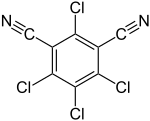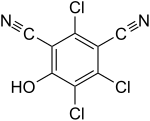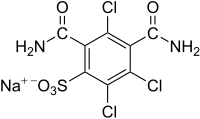Chlorothalonil
| Structural formula | |||||||||||||||||||
|---|---|---|---|---|---|---|---|---|---|---|---|---|---|---|---|---|---|---|---|

|
|||||||||||||||||||
| General | |||||||||||||||||||
| Surname | Chlorothalonil | ||||||||||||||||||
| other names |
|
||||||||||||||||||
| Molecular formula | C 8 Cl 4 N 2 | ||||||||||||||||||
| Brief description |
colorless crystalline solid |
||||||||||||||||||
| External identifiers / databases | |||||||||||||||||||
|
|||||||||||||||||||
| properties | |||||||||||||||||||
| Molar mass | 265.91 g mol −1 | ||||||||||||||||||
| Physical state |
firmly |
||||||||||||||||||
| Melting point |
250-251 ° C |
||||||||||||||||||
| boiling point |
350 ° C |
||||||||||||||||||
| Vapor pressure |
<1.3 Pa (40 ° C) |
||||||||||||||||||
| solubility |
very bad in water (0.6 mg l −1 at 20 ° C) |
||||||||||||||||||
| safety instructions | |||||||||||||||||||
|
|||||||||||||||||||
| Toxicological data | |||||||||||||||||||
| As far as possible and customary, SI units are used. Unless otherwise noted, the data given apply to standard conditions . | |||||||||||||||||||
Chlorthalonil ( English Chlorothalonil ) is a fungicide that was introduced in 1966 by Diamond Alkali Company . As a means against fungal attack, the original area of application is crop protection , especially grain cultivation. It has been banned in the EU since January 1st, 2020. However, it can also be detected in materials contaminated with wood preservatives and can therefore also be found indoors.
Extraction and presentation
Chlorothalonil can be prepared starting from m -Xylene . This reacts by ammoxidation to form isophthalonitrile , which is chlorinated .
effect
Chlorthalonil is a non-systemic foliar fungicide with a protective effect. It reacts with thiols , especially glutathione , the germinating fungal cells. This leads to the interruption of glycolysis and thus to the death of the fungal cells.
use
Chlorthalonil is used worldwide to combat a wide variety of fungal diseases in a large number of cultures. About 4,500 tons were consumed in the US in 2011. These were mainly used in peanut, potato and tomato cultivation. Most recently, around 30 tons of the pesticide were used on the fields in Switzerland every year.
Due to its low solubility in water and its UV stability, it is also suitable as a paint fungicide. The spectrum of activity of Chlorthalonil covers fungi, yeasts and algae, but shows some gaps as far as fungi are concerned (e.g. for Trichoderma viride and Rhizopus stolonifer ).
Trade names
Daconil, Bravo, Exotherm, Termil.
Admission
In the European Union , as well as in Austria and Germany, products with this active ingredient were mainly approved for growing grain. On April 29, 2019, it was decided to withdraw the approval in the EU by November 20, 2019 at the latest. Remaining stocks can be used up until May 20, 2020.
Switzerland
In the Swiss agriculture chlorothalonil-containing products were from the 1970s approved by the end of 2019 for a variety of applications in arable farming, vegetables, wine and ornamental horticulture.
In the Eastern Switzerland 300 were drinking water and groundwater samples taken in which it was found that the official high of chlorothalonil in excess of 10% was exceeded of the samples. In the canton of Solothurn , this maximum value was exceeded in 18 municipalities . The Solothurnian Gäu and the water authority are particularly affected. In the canton of Zurich , of 92 monitored groundwater wells, 29 had exceeded the limit value. In the drinking water of the canton of Aargau , the limit value was exceeded in every eighth municipality. Based on the principle of public disclosure , the canton of Bern published a list on February 6, 2020 of the drinking water catchments affected in which the maximum values for chlorothalonil metabolites were exceeded as part of official measurements in 2019. In the canton of Lucerne , too , some exceedances of maximum values were reported, for example from Hochdorf and other communities in the Lucerne Seetal . The cantons of Friborg , Geneva , Schaffhausen , Ticino , Thurgau , Vaud and Zug are also severely affected by the contamination.
In order to lower the concentration in the drinking water again, z. B. the contaminated water can be diluted with less contaminated water such. B. also in Villmergen and Obersiggenthal in Aargau . Alternatively, wells are also completely disconnected from the grid, such as in Worben in Bern and Wäldi in Thurgau .
The Seeländische Wasserversorgung SWG in Worben has installed a pilot system for reverse osmosis and intends to install a 1.7 million CHF system for the filtration of drinking water in the Worben version. The concentrations of the chlorothalonil metabolites after filtration are all below the quantification limit.
In September 2019, the municipal council and municipal utilities of Villmergen asked the agricultural sector to stop using chlorothalonil. In April 2019, the pesticide's approval was withdrawn in the EU. Switzerland also initiated a ban. The Federal Office for Agriculture wrote: "The information provided by the manufacturers is currently being evaluated by the Federal Office for Food Safety ." A final decision on the withdrawal for this substance was announced by the end of 2019. As a result, the Swiss Farmers' Association called for no more chlorothalonil stocks to be created. Fenaco stopped selling pesticides containing chlorothalonil. On December 12, 2019, the Federal Office for Agriculture announced that the approval will be withdrawn with immediate effect and that a ban on use will come into force on January 1, 2020.
A study published in the science magazine Water Research in June 2020 made public that researchers from the Swiss water research institute Eawag found residues of the pesticide chlorothalonil in the Evian mineral water used for reference purposes (to calibrate the measuring instruments) (6 nanograms per liter).
toxicity
The European Food Safety Authority (EFSA) published a report on the risk assessment of chlorothalonil in early 2018. In this, the substance is classified as slightly acutely toxic when ingested orally or dermally. If inhaled, however, it is very toxic and can also cause irritation of the respiratory tract. Chlorthalonil is not irritating to the skin, but it can cause allergies and damage if it comes into contact with the eyes. In animal experiments on rats and mice, tumors were found in the kidneys. For this reason, chlorothalonil is suspected of being carcinogenic for humans as well. No evidence of genotoxicity , neurotoxicity or immunotoxicity could be found. In addition, the fungicide is not an endocrine disruptor .
The EFSA specifies a permitted daily dose (ETD) of 0.015 mg / kg body weight and an acute reference dose (ARfD) of 0.05 mg / kg body weight. In Switzerland z. B. for celery a relatively high residue level allowed (RHG) of 10 mg per kilogram of chlorothalonil. Accordingly, in order not to exceed the ETD, a person may ingest a maximum of 1.5 grams of celery per kilogram of body weight and day. 5 grams in relation to the ARfD. In the case of drinking water, however, a much stricter MRL of 0.1 micrograms (μg) per liter applies. Theoretically, water with an MRL of 0.1 μg chlorothalonil could absorb up to 150 liters per day and kilogram of body weight so that the ETD can be adhered to, respectively. 500 liters in relation to the ARfD. This calculation example shows that the amount absorbed from vegetables etc. sprayed directly with pesticides can be many times higher than from drinking water. Nevertheless, there was a real media hype about the quality of the drinking water.
Chlorthalonil is listed in the MAK List III B (substances with justified suspicion of carcinogenic potential) and as an allergic substance ( sensitization of the skin ).
Metabolites
In addition to the actual active ingredient, metabolites of chlorothalonil are also of toxicological relevance. 20 metabolites are known. For example, 2,4,5-trichloro-6-hydroxybenzene-1,3-dicarbonitrile , which is formed in plants and animals, is acutely toxic when ingested. Other important metabolites are chlorothalonil sulfonic acid and R471811 , which, unlike the phenols R611968, SYN507900 and SYN548580, cannot be removed from the water by ozonation or activated carbon, but at most through dense membranes (nanofiltration, reverse osmosis).
Metabolites can exceed the valid limit values many times over. A measurement in Brügg (CH) on April 6, 2020 showed that the valid limit value of R471811 was exceeded 3.4 times.
Web links
Individual evidence
- ↑ a b c d e Entry on chlorothalonil. In: Römpp Online . Georg Thieme Verlag, accessed on May 29, 2014.
- ↑ a b c d e f g Entry on chlorothalonil in the GESTIS substance database of the IFA , accessed on February 1, 2016(JavaScript required) .
- ↑ Entry on chlorothalonil in the Classification and Labeling Inventory of the European Chemicals Agency (ECHA), accessed on February 1, 2016. Manufacturers or distributors can expand the harmonized classification and labeling .
- ↑ Entry on chlorothalonil in the ChemIDplus database of the United States National Library of Medicine (NLM), accessed on June 25, 2019.
- ↑ a b Worries about drinking water - because of the new pesticide ban. Observer , accessed January 16, 2020 .
- ↑ a b Thomas A. Unger: Pesticide Synthesis Handbook . William Andrew, 1996, ISBN 0-8155-1853-6 , pp. 819 ( preview ).
- ↑ a b c Angelique Beldner: Ban comes in autumn - carcinogenic pesticide in Swiss drinking water. In: srf.ch . June 20, 2019, accessed June 22, 2019 .
- ↑ a b Directorate-General for Health and Food Safety of the European Commission: Entry on chlorothalonil in the EU pesticide database; Entry in the national registers of plant protection products in Switzerland , Austria and Germany ; accessed on December 8, 2019.
- ↑ a b Federal Office for the Environment : Chlorothalonil metabolites in groundwater: First assessment of the Swiss pollution. In: admin.ch. May 12, 2020, accessed May 12, 2020 .
- ↑ Chlorothalonil in drinking water - Can Olten water supply help the population in the Gäu? In: srf.ch . September 16, 2019, accessed September 18, 2019 .
- ↑ Urs Moser: Pesticide residues have to go, does the canton help the communities? In: solothurnerzeitung.ch . December 10, 2019, accessed February 1, 2020 .
- ↑ Winterthur helps communities with drinking water. In: toponline.ch. December 18, 2019, accessed February 11, 2020 .
- ↑ Because of pesticides in the water: Canton takes measures to protect drinking water. In: aargauerzeitung.ch . December 23, 2019, accessed December 23, 2019 .
- ↑ Economic, Energy and Environment Directorate: Chlorothalonil metabolites in drinking water: Canton publishes the measured values. In: be.ch . February 6, 2020, accessed March 8, 2020 .
- ↑ State Chancellery Lucerne: Canton Lucerne provides information on chlorothalonil residues in groundwater and drinking water. In: lu.ch . March 12, 2020, accessed March 12, 2020 .
- ↑ Zug waterworks: drinking water situation in Hochdorf / LU. In: wwz.ch . March 12, 2020, accessed March 12, 2020 .
- ↑ Alexandra Aronsky and Christa Gall: Fungicide in drinking water - danger from the tap. In: srf.ch . July 18, 2019, accessed July 19, 2019 .
- ↑ Gundi Klemm: 2150 cubic meters of water every day: Recherswil delivers clean drinking water to Biberist. In: solothurnerzeitung.ch . December 20, 2019, accessed December 22, 2019 .
- ↑ Pirmin Kramer: SP-Grossrat demands: Source contaminated with pesticides should be taken off the grid. In: badenertagblatt.ch . October 6, 2019, accessed October 6, 2019 .
- ↑ Thomas Angeli: Because of the chlorothalonil ban: worries about drinking water. In: observer.ch . December 23, 2019, accessed December 24, 2019 .
- ↑ Wäldi intervenes in the drinking water network because of chlorothalonil. In: toponline.ch. February 10, 2020, accessed February 11, 2020 .
- ^ Analyzes per municipality - SWG. Retrieved May 13, 2020 (German).
- ↑ Andrea Weibel: Too many toxins: Villmergen has to buy water from Wohlen. In: aargauerzeitung.ch . September 6, 2019, accessed September 6, 2019 .
- ↑ Stephan Weber: Contaminated drinking water - Isn't chlorothalonil banned at all? In: srf.ch . November 15, 2019, accessed November 16, 2019 .
- ↑ Stefan Häne: Controversial pesticide banned from the shelves. In: tagesanzeiger.ch . November 20, 2019, accessed December 1, 2019 .
- ↑ Federal Office for Agriculture: Approval for chlorothalonil is withdrawn with immediate effect. December 12, 2019, accessed December 16, 2019 .
- ↑ «Probably carcinogenic» - the federal government bans the pesticide chlorothalonil. In: srf.ch. December 12, 2019, accessed December 12, 2019 .
- ↑ Angelique Beldner: Residues in drinking water: approval for the fungicide chlorothalonil is withdrawn with immediate effect. In: nzz.ch. December 12, 2019, accessed December 12, 2019 .
- ↑ https://www.bazonline.ch/selbst-im-evian-hat-es-pestizid-rueckstaende-550539644649
- ↑ a b c d Maria Arena, Domenica Auteri, Stefania Barmaz, Giulia Bellisai, Alba Brancato: Peer review of the pesticide risk assessment of the active substance chlorothalonil . In: EFSA Journal . tape 16 , no. 1 , 2018, p. e05126 , doi : 10.2903 / j.efsa.2018.5126 .
- ↑ Ordinance of the EDI on the maximum levels for pesticide residues in or on products of plant and animal origin. In: admin.ch . Retrieved February 6, 2020 .
- ↑ a b Chlorothalonil Metabolites: A Challenge for the Water Supply Eawag The Water Research Institute of the ETH Domain. fact sheet. February 2020.
- ↑ Water samples in the area of the SWG municipality: Brügg. In: wessling.ch. April 16, 2020, accessed May 4, 2020 .







